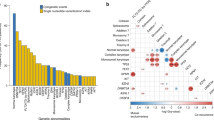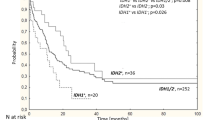Abstract
Polymorphisms of DNA repair genes RAD51 and XRCC3 increase susceptibility to acute myeloid leukemia (AML) in adults, an effect enhanced by deletion of the glutathione-S-transferase M1 (GSTM1) gene. In this study, we genotyped 452 children with de novo AML treated on CCG protocols 2941 and 2961 and compared genotype frequencies with those of normal blood donors, and analyzed the impact of genotype on outcome of therapy. XRCC3 Thr241Met, RAD51 G135C and GSTM1 genotypes did not increase susceptibility to AML when assessed singly. In contrast, when XRCC3 and RAD51 genotypes were examined together a significant increase in susceptibility to AML was seen in children with variant alleles. Analysis of outcome of therapy showed that patients heterozygous for the XRCC3 Thr241Met allele had improved post-induction disease-free survival compared to children homozygous for the major or minor allele, each of whom had similar outcomes. Improved survival was due to reduced relapse in the heterozygous children, and this effect was most marked in children randomized to therapy likely to generate DNA double-strand breaks (etoposide, daunomycin), compared with anti-metabolite (fludarabine, cytarabine) based therapy. In contrast, RAD51 G135C and the GSTM1 deletion polymorphism did not influence outcome of AML therapy in our study population.
This is a preview of subscription content, access via your institution
Access options
Subscribe to this journal
Receive 12 print issues and online access
$259.00 per year
only $21.58 per issue
Buy this article
- Purchase on Springer Link
- Instant access to full article PDF
Prices may be subject to local taxes which are calculated during checkout

Similar content being viewed by others
References
Kennedy RD, D'Andrea AD . DNA repair pathways in clinical practice: lessons from pediatric cancer susceptibility syndromes. J Clin Oncol 2006; 24: 3799–3808. Review.
Ishikawa K, Ishii H, Saito T . DNA damage-dependent cell cycle checkpoints and genomic stability. DNA Cell Biol 2006; 25: 406–411. Review.
Goode EL, Ulrich CM, Potter JD . Polymorphisms in DNA repair genes and associations with cancer risk. Cancer Epidemiol Biomarkers Prev 2002; 11: 1513–1530.
Khanna KK, Jackson SP . DNA double-strand breaks: signaling, repair and the cancer connection. Nat Genet 2001; 27: 247–254.
O'Driscoll M, Jeggo PA . The role of double-strand break repair—insights from human genetics. Nat Rev Genet 2006; 7: 45–54.
Baumann P, Benson FE, West SC . Human Rad51 protein promotes ATP-dependent homologous pairing and strand transfer reactions in vitro. Cell 1996; 87: 757–766.
Bishop DK, Ear U, Bhattacharyya A, Calderone C, Beckett M, Weichselbaum RR et al. Xrcc3 is required for assembly of Rad51 complexes in vivo. J Biol Chem 1998; 273: 21482–21488.
Schild D, Lio Y, Collins DW, Tsomondo T, Chen DJ . Evidence for simultaneous protein interactions between human Rad51 paralogs. J Biol Chem 2000; 275: 16443–16449.
Masson JY, Stasiak AZ, Stasiak A, Benson FE, West SC . Complex formation by the human RAD51C and XRCC3 recombination repair proteins. Proc Natl Acad Sci USA 2001; 98: 8440–8446.
Yamada NA, Hinz JM, Kopf VL, Segalle KD, Thompson LH . XRCC3 ATPase activity is required for normal XRCC3-Rad51C complex dynamics and homologous recombination. J Biol Chem 2004; 279: 23250–23254. Epub 2004 Mar 22.
Liu N, Lamerdin JE, Tebbs RS, Schild D, Tucker JD, Shen MR et al. XRCC2 and XRCC3, new human Rad51-family members, promote chromosome stability and protect against DNA cross-links and other damages. Mol Cell 1998; 1: 783–793.
Kurumizaka H, Ikawa S, Nakada M, Eda K, Kagawa W, Takata M et al. Homologous-pairing activity of the human DNA-repair proteins Xrcc3.Rad51C. Proc Natl Acad Sci USA 2001; 98: 5538–5543.
Henry-Mowatt J, Jackson D, Masson JY, Johnson PA, Clements PM, Benson FE et al. XRCC3 and Rad51 modulate replication fork progression on damaged vertebrate chromosomes. Mol Cell 2003; 11: 1109–1117.
Sonoda E, Sasaki MS, Buerstedde JM, Bezzubova O, Shinohara A, Ogawa H et al. Rad51-deficient vertebrate cells accumulate chromosomal breaks prior to cell death. EMBO J 1998; 17: 598–608.
Yoshihara T, Ishida M, Kinomura A, Katsura M, Tsuruga T, Tashiro S et al. XRCC3 deficiency results in a defect in recombination and increased endoreduplication in human cells. EMBO J 2004; 23: 670–680. Epub 2004 Jan 29.
Bleuyard JY, White CI . The Arabidopsis homologue of Xrcc3 plays an essential role in meiosis. EMBO J 2004; 23: 439–449. Epub 2004 Jan 15.
Wei C, Skopp R, Takata M, Takeda S, Price CM . Effects of double-strand break repair proteins on vertebrate telomere structure. Nucleic Acids Res 2002; 30: 2862–2870.
Seedhouse C, Faulkner R, Ashraf N, Das-Gupta E, Russell N . Polymorphisms in genes involved in homologous recombination repair interact to increase the risk of developing acute myeloid leukemia. Clin Cancer Res 2004; 10: 2675–2680.
Levy-Lahad E, Lahad A, Eisenberg S, Dagan E, Paperna T, Kasinetz L et al. A single nucleotide polymorphism in the RAD51 gene modifies cancer risk in BRCA2 but not BRCA1 carriers. Proc Natl Acad Sci USA 2001; 98: 3232–3236.
Winsey SL, Haldar NA, Marsh HP, Bunce M, Marshall SE, Harris AL et al. A variant within the DNA repair gene XRCC3 is associated with the development of melanoma skin cancer. Cancer Res 2000; 60: 5612–5616.
Matullo G, Guarrera S, Carturan S, Peluso M, Malaveille C, Davico L et al. DNA repair gene polymorphisms, bulky DNA adducts in white blood cells and bladder cancer in a case-control study. Int J Cancer 2001; 92: 562–567.
Kuschel B, Auranen A, McBride S, Novik KL, Antoniou A, Lipscombe JM et al. Variants in DNA double-strand break repair genes and breast cancer susceptibility. Hum Mol Genet 2002; 11: 1399–1407.
Popanda O, Schattenberg T, Phong CT, Butkiewicz D, Risch A, Edler L et al. Specific combinations of DNA repair gene variants and increased risk for non-small cell lung cancer. Carcinogenesis 2004; 25: 2433–2441. Epub 2004 Aug 27.
Wang LE, Bondy ML, Shen H, El-Zein R, Aldape K, Cao Y et al. Polymorphisms of DNA repair genes and risk of glioma. Cancer Res 2004; 64: 5560–5563.
Matullo G, Palli D, Peluso M, Guarrera S, Carturan S, Celentano E et al. XRCC1, XRCC3, XPD gene polymorphisms, smoking and (32)P-DNA adducts in a sample of healthy subjects. Carcinogenesis 2001; 22: 1437–1445.
Au WW, Salama SA, Sierra-Torres CH . Functional characterization of polymorphisms in DNA repair genes using cytogenetic challenge assays. Environ Health Perspect 2006; 111: 1843–1850.
Aka P, Mateuca R, Buchet JP, Thierens H, Kirsch-Volders M . Are genetic polymorphisms in OGG1, XRCC1 and XRCC3 genes predictive for the DNA strand break repair phenotype and genotoxicity in workers exposed to low dose ionising radiations? Mutat Res 2004; 556: 169–181.
Angelini S, Kumar R, Carbone F, Maffei F, Forti GC, Violante FS et al. Micronuclei in humans induced by exposure to low level of ionizing radiation: influence of polymorphisms in DNA repair genes. Mutat Res 2005; 570: 105–117.
Jiao L, Chang P, Firozi PF, Lai D, Abbriuzzese JL, Li D . Polymorphisms of phase II xenobiotic-metabolizing and DNA repair genes and in vitro N-ethyl-N-nitrosourea-induced 06-ethylguanine levels in human lymphocytes. Mutat Res 2007; 627: 146–157. Epub 2006 Dec 8.
Savas S, Kim DY, Ahmad MF, Shariff M, Ozcelik H . Identifying functional genetic variants in DNA repair pathways using protein conservation analysis. Cancer Epidemiol Biomarkers Prev 2004; 13: 801–807.
Hasselbach L, Haase S, Fischer D, Kolberg HC, Sturzbecher HW . Characterisation of the promoter region of the human DNA-repair gene Rad51. Eur J Gynaecol Oncol 2005; 26: 589–598.
Davies SM, Robison LL, Buckley JD, Tjoa T, Woods WG, Radloff GA et al. Glutathione-s-transferase polymorphisms and outcome of chemotherapy in childhood AML. J Clin Oncol 2001; 19: 1279–1287.
Lange BJ, Dinndorf P, Smith FO, Arndt C, Barnard D, Feig S et al. Pilot study of idarubicin-based intensive-timing induction therapy for children with previously untreated acute myeloid leukemia: Children's Cancer Group Study 2941. J Clin Oncol 2004; 22: 150–156.
Aplenc R, Alonzo TA, Gerbing RB, Smith FO, Meshinchi S, Ross JA et al. Ethnicity and survival in childhood acute myeloid leukemia: a report from the Children's Oncology Group. Blood 2006; 108: 74–80. Epub 2006 Mar 14.
Auranen A, Song H, Waterfall C, Dicioccio RA, Kuschel B, Kjaer SK et al. Polymorphisms in DNA repair genes and epithelial ovarian cancer risk. Int J Cancer 2005; 117: 611–618.
Kiffmeyer WR, Langer E, Davies SM, Envall J, Robison LL, Ross JA . Genetic polymorphisms in the Hmong population: implications for cancer etiology and survival. Cancer 2004; 100: 411–417.
Kaplan E, Meier P, Kaplan E, Meier P . Nonparametric estimation from incomplete observations. J Am Stat Assoc 1958; 53: 457–481.
Greenwood M . The Natural Duration of Cancer. Report on Public Health and Medical Subjects. His Majesty's Stationery Office: London, England, 1926, pp 1–26..
Kalbfleisch J, Prentice R . The Statistical Analysis of Failure Time Data. John Wiley: New York, 1980, pp 20–23.
Gray R . A class of K-sample tests for comparing the cumulative incidence of a competing risk. Ann Stat 1988; 16: 1141–1154.
Davies SM, Robison LL, Buckley JD, Radloff GA, Ross JA, Perentesis JP . GST polymorphisms in children with myeloid leukemia: a Children's Cancer Group (CCG) study. Cancer Epidemiol Biomarkers 2000; 9: 563–566.
Grimwade D, Walker H, Harrison G, Oliver F, Chatters S, Harrison CJ et al. The predictive value of hierarchical cytogenetic classification in older adults with acute myeloid leukemia (AML): analysis of 1065 patients entered into the United Kingdom Medical Research Council AML11 trial. Blood 2001; 98: 1312–1320.
Ryk C, Kumar R, Sanyal S, Verdier PJ, Hemminki K, Larsson P et al. Influence of polymorphism in DNA repair and defence genes on p53 mutations in bladder tumours. Cancer Lett 2006; 241: 142–149.
Han S, Zhang HT, Wang Z, Xie Y, Tang R, Mao Y et al. DNA repair gene XRCC3 polymorphisms and cancer risk: a meta-analysis of 48 case-control studies. Eur J Hum Genet 2006; 14: 1136–1144.
Savas S, Kim DY, Ahmad MF, Shariff M, Ozcelik H . Identifying functional genetic variants in DNA repair pathway using protein conservation analysis. Cancer Epidemiol Biomarkers Prev 2004; 13: 801–807.
Duarte MC, Colombo J, Rossit AR, Caetano A, Borim AA, Wornrath D et al. Polymorphisms of DNA repair genes XRCC1 and XRCC3, interaction with environmental exposure and risk of chronic gastritis and gastric cancer. World J Gastroenterol 2005; 11: 6593–6600.
Gal TJ, Huang WY, Chen C, Hayes RB, Schwartz SM . DNA repair gene polymorphisms and risk of second primary neoplasms and mortality in oral cancer patients. Laryngoscope 2005; 115: 2221–2231. Erratum in: Laryngoscope. 2006 116(3):507.
Lindh AR, Rafii S, Schultz N, Cox A, Helleday T . Mitotic defects in XRCC3 variants T241M and D213N and their relation to cancer susceptibility. Hum Mol Genet 2006; 15: 1217–1224. Epub 2006 Feb 27.
Araujo FD, Pierce AJ, Stark JM, Jasin M . Variant XRCC3 implicated in cancer is functional in homology-directed repair of double-strand breaks. Oncogene 2002; 21: 4176–4180.
Acknowledgements
This work was supported by R01CA93552-01 (SMD), R21 CA10262-01, R01 CA114563-01, (SM) and COG Grant CA 98543. A complete listing of grant support for research conducted by CCG and POG before initiation of the COG grant in 2003 is available online at: http://www.childrensoncologygroup.org/admin/grantinfo.htm
Author information
Authors and Affiliations
Corresponding author
Rights and permissions
About this article
Cite this article
Bhatla, D., Gerbing, R., Alonzo, T. et al. DNA repair polymorphisms and outcome of chemotherapy for acute myelogenous leukemia: a report from the Children's Oncology Group. Leukemia 22, 265–272 (2008). https://doi.org/10.1038/sj.leu.2405000
Received:
Revised:
Accepted:
Published:
Issue Date:
DOI: https://doi.org/10.1038/sj.leu.2405000
Keywords
This article is cited by
-
Ethnicity-stratified analysis of the association between XRCC3 Thr241Met polymorphism and leukemia: an updated meta-analysis
BMC Medical Genomics (2021)
-
RAD 51 Gene 135G/C polymorphism and the risk of four types of common cancers: a meta-analysis
Diagnostic Pathology (2014)
-
Genetic 135G/C polymorphism of RAD51 gene and risk of cancer: a meta-analysis of 28,956 cases and 28,372 controls
Familial Cancer (2014)
-
Glutathione S-transferase gene polymorphisms and susceptibility to chronic myeloid leukemia
Tumor Biology (2014)
-
Association between RAD51 gene polymorphism (-135G/C) and susceptibility of myelodysplastic syndrome and acute leukemia: evidence based on a meta-analysis
Tumor Biology (2014)



